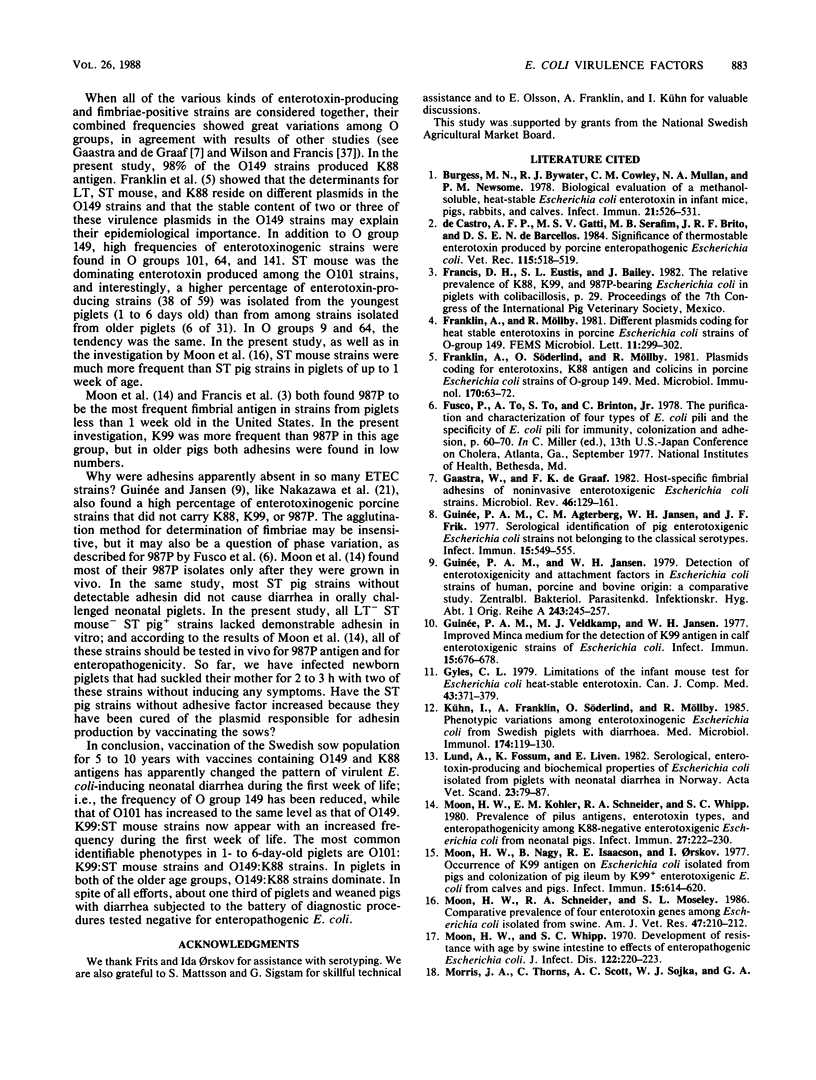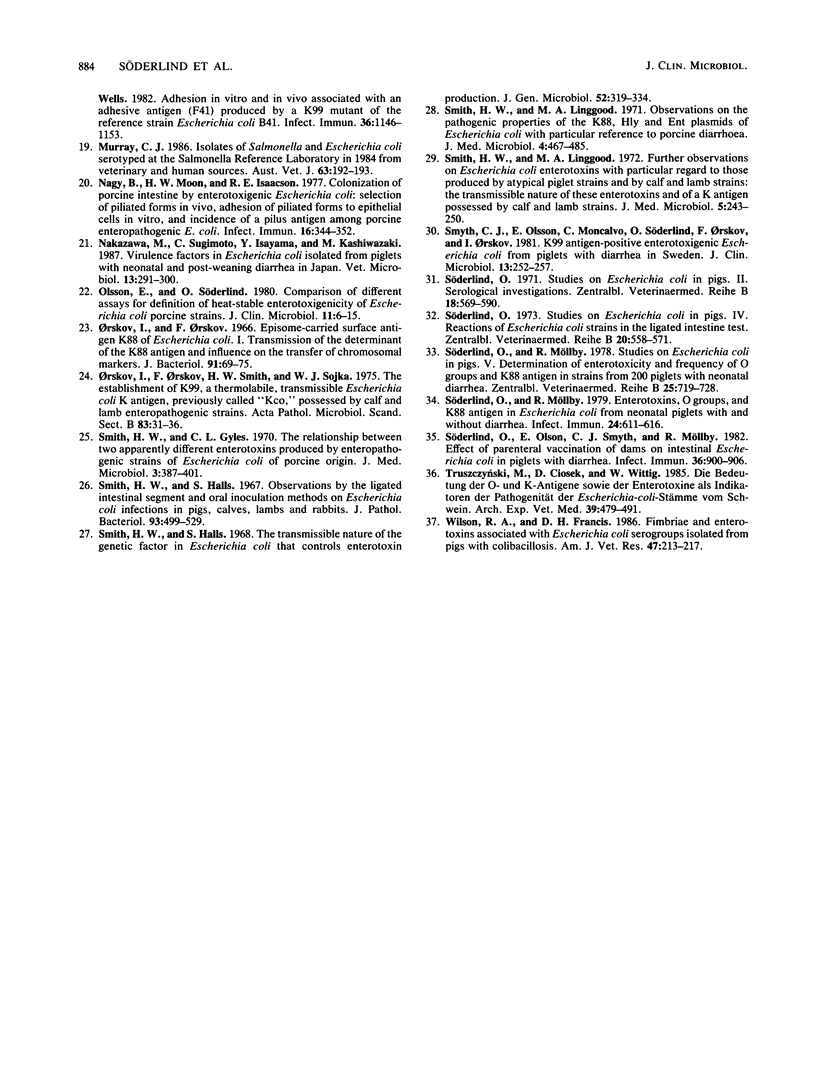Abstract
Parenteral vaccination of sows against Escherichia coli diarrhea in their newborn piglets has become more common during the last decade in Sweden, and the vaccination has generally had positive effects. For more than 20 years we have investigated E. coli strains isolated from piglets and weaned pigs with enteric disorders, noting the presence of O groups, enterotoxins, and adhesins. There has been a continuous change in the frequency of these virulence factors. The present study was performed during 1983 and 1984 to follow this change, since such information is essential for the proper choice of vaccines. A total of 856 E. coli strains were obtained from 683 herds divided into three age groups: 1 to 6 days old, 1 to 6 weeks old, and weaned pigs. O group 149 still dominated in the last two age groups, while O group 101 was, for the first time, the most frequent O group in neonatal piglets. All but four O149 strains carried the K88 antigen, which was found in only one other strain (O group 8). K99 antigen was most often found in O groups 101 and 64, and among all the K99 strains ST mouse was the most common (44 of 57), followed by ST mouse-ST pig strains (12 of 57). The 987P antigen was demonstrated in 26 strains belonging to O groups 141 and OX46 and nontypable strains. Two strains belonging to O group 101 were positive for F41 antigen; one of them also carried the K99 antigen. Among all non-O149 strains, ST mouse was the most common type of enterotoxigenic E. coli ( n = 88), followed in decreasing order by ST mouse-ST pig strains ( n = 69) and ST pig strains ( n = 33). In 114 strains producing enterotoxins no adhesive factor was found. Thus, vaccination of the Swedish sow population for more than 5 years with vaccines containing O149 and K88 antigens has apparently changed the pattern of enterotoxigenic E. coli in neonatal diarrhea. The frequency of O149:K88 strains has been reduced, and O101:K99:ST mouse strains now dominate. However, O149 strains remain the dominant O group in piglets older than 1 week. In spite of all our diagnostic efforts, no virulence factors were detected in about one third of the piglets and weaned pigs with enteric disorders.
Full text
PDF





Selected References
These references are in PubMed. This may not be the complete list of references from this article.
- Burgess M. N., Bywater R. J., Cowley C. M., Mullan N. A., Newsome P. M. Biological evaluation of a methanol-soluble, heat-stable Escherichia coli enterotoxin in infant mice, pigs, rabbits, and calves. Infect Immun. 1978 Aug;21(2):526–531. doi: 10.1128/iai.21.2.526-531.1978. [DOI] [PMC free article] [PubMed] [Google Scholar]
- Franklin A., Söderlind, Möllby R. Plasmids coding for enterotoxins, K88 antigen and colicins in porcine Escherichia coli strains of O-group 149. Med Microbiol Immunol. 1981;170(2):63–72. doi: 10.1007/BF02122670. [DOI] [PubMed] [Google Scholar]
- Gaastra W., de Graaf F. K. Host-specific fimbrial adhesins of noninvasive enterotoxigenic Escherichia coli strains. Microbiol Rev. 1982 Jun;46(2):129–161. doi: 10.1128/mr.46.2.129-161.1982. [DOI] [PMC free article] [PubMed] [Google Scholar]
- Guinée P. A., Agterberg C. M., Jansen W. H., Frik J. F. Serological identification of pig enterotoxigenic Escherichia coli strains not belonging to the classical serotypes. Infect Immun. 1977 Feb;15(2):549–555. doi: 10.1128/iai.15.2.549-555.1977. [DOI] [PMC free article] [PubMed] [Google Scholar]
- Guinée P. A., Jansen W. H. Detection of enterotoxigenicity and attachment factors in Escherichia coli strains of human, porcine and bovine origin; a comparative study. Zentralbl Bakteriol Orig A. 1979 Apr;243(2-3):245–257. [PubMed] [Google Scholar]
- Guinée P. A., Veldkamp J., Jansen W. H. Improved minca medium for the detection of K99 antigen in calf enterotoxigenic strains of Escherichia coli. Infect Immun. 1977 Feb;15(2):676–678. doi: 10.1128/iai.15.2.676-678.1977. [DOI] [PMC free article] [PubMed] [Google Scholar]
- Gyles C. L. Limitations of the infant mouse test for Escherichia coli heat stable enterotoxin. Can J Comp Med. 1979 Oct;43(4):371–379. [PMC free article] [PubMed] [Google Scholar]
- Kühn I., Franklin A., Söderlind O., Möllby R. Phenotypic variations among enterotoxinogenic Escherichia coli from Swedish piglets with diarrhoea. Med Microbiol Immunol. 1985;174(3):119–130. doi: 10.1007/BF02298122. [DOI] [PubMed] [Google Scholar]
- Lund A., Fossum K., Liven E. Serological, enterotoxin-producing and biochemical properties of Escherichia coli isolated from piglets with neonatal diarrhea in Norway. Acta Vet Scand. 1982;23(1):79–87. doi: 10.1186/BF03546824. [DOI] [PMC free article] [PubMed] [Google Scholar]
- Moon H. W., Kohler E. M., Schneider R. A., Whipp S. C. Prevalence of pilus antigens, enterotoxin types, and enteropathogenicity among K88-negative enterotoxigenic Escherichia coli from neonatal pigs. Infect Immun. 1980 Jan;27(1):222–230. doi: 10.1128/iai.27.1.222-230.1980. [DOI] [PMC free article] [PubMed] [Google Scholar]
- Moon H. W., Nagy B., Isaacson R. E., Orskov I. Occurrence of K99 antigen on Escherichia coli isolated from pigs and colonization of pig ileum by K99+ enterotoxigenic E. coli from calves and pigs. Infect Immun. 1977 Feb;15(2):614–620. doi: 10.1128/iai.15.2.614-620.1977. [DOI] [PMC free article] [PubMed] [Google Scholar]
- Moon H. W., Schneider R. A., Moseley S. L. Comparative prevalence of four enterotoxin genes among Escherichia coli isolated from swine. Am J Vet Res. 1986 Feb;47(2):210–212. [PubMed] [Google Scholar]
- Moon H. W., Whipp S. C. Development of resistance with age by swine intestine to effects of enteropathogenic Escherichia coli. J Infect Dis. 1970 Sep;122(3):220–223. doi: 10.1093/infdis/122.3.220. [DOI] [PubMed] [Google Scholar]
- Morris J. A., Thorns C., Scott A. C., Sojka W. J., Wells G. A. Adhesion in vitro and in vivo associated with an adhesive antigen (F41) produced by a K99 mutant of the reference strain Escherichia coli B41. Infect Immun. 1982 Jun;36(3):1146–1153. doi: 10.1128/iai.36.3.1146-1153.1982. [DOI] [PMC free article] [PubMed] [Google Scholar]
- Murray C. J. Isolates of salmonella and Escherichia coli serotyped at the Salmonella Reference Laboratory in 1984 from veterinary and human sources. Aust Vet J. 1986 Jun;63(6):192–193. doi: 10.1111/j.1751-0813.1986.tb02974.x. [DOI] [PubMed] [Google Scholar]
- Nagy B., Moon H. W., Isaacson R. E. Colonization of porcine intestine by enterotoxigenic Escherichia coli: selection of piliated forms in vivo, adhesion of piliated forms to epithelial cells in vitro, and incidence of a pilus antigen among porcine enteropathogenic E. coli. Infect Immun. 1977 Apr;16(1):344–352. doi: 10.1128/iai.16.1.344-352.1977. [DOI] [PMC free article] [PubMed] [Google Scholar]
- Nakazawa M., Sugimoto C., Isayama Y., Kashiwazaki M. Virulence factors in Escherichia coli isolated from piglets with neonatal and post-weaning diarrhea in Japan. Vet Microbiol. 1987 Apr;13(4):291–300. doi: 10.1016/0378-1135(87)90060-5. [DOI] [PubMed] [Google Scholar]
- Olsson E., Söderlind O. Comparison of different assays for definition of heat-stable enterotoxigenicity of Escherichia coli porcine strains. J Clin Microbiol. 1980 Jan;11(1):6–15. doi: 10.1128/jcm.11.1.6-15.1980. [DOI] [PMC free article] [PubMed] [Google Scholar]
- Orskov I., Orskov F. Episome-carried surface antigen K88 of Escherichia coli. I. Transmission of the determinant of the K88 antigen and influence on the transfer of chromosomal markers. J Bacteriol. 1966 Jan;91(1):69–75. doi: 10.1128/jb.91.1.69-75.1966. [DOI] [PMC free article] [PubMed] [Google Scholar]
- Orskov I., Orskov F., Smith H. W., Sojka W. J. The establishment of K99, a thermolabile, transmissible escherichia coli K antigen, previously called "Kco", possessed by calf and lamb enteropathogenic strains. Acta Pathol Microbiol Scand B. 1975 Feb;83(1):31–36. doi: 10.1111/j.1699-0463.1975.tb00066.x. [DOI] [PubMed] [Google Scholar]
- Smith H. W., Gyles C. L. The relationship between two apparently different enterotoxins produced by enteropathogenic strains of Escherichia coli of porcine origin. J Med Microbiol. 1970 Aug;3(3):387–401. doi: 10.1099/00222615-3-3-387. [DOI] [PubMed] [Google Scholar]
- Smith H. W., Halls S. Observations by the ligated intestinal segment and oral inoculation methods on Escherichia coli infections in pigs, calves, lambs and rabbits. J Pathol Bacteriol. 1967 Apr;93(2):499–529. doi: 10.1002/path.1700930211. [DOI] [PubMed] [Google Scholar]
- Smith H. W., Linggood M. A. Further observations on Escherichia coli enterotoxins with particular regard to those produced by atypical piglet strains and by calf and lamb strains: the transmissible nature of these enterotoxins and of a K antigen possessed by calf and lamb strains. J Med Microbiol. 1972 May;5(2):243–250. doi: 10.1099/00222615-5-2-243. [DOI] [PubMed] [Google Scholar]
- Smith H. W., Linggood M. A. Observations on the pathogenic properties of the K88, Hly and Ent plasmids of Escherichia coli with particular reference to porcine diarrhoea. J Med Microbiol. 1971 Nov;4(4):467–485. doi: 10.1099/00222615-4-4-467. [DOI] [PubMed] [Google Scholar]
- Smyth C. J., Olsson E., Moncalvo C., Söderlind O., Orskov F., Orskov I. K99 antigen-positive enterotoxigenic Escherichia coli from piglets with diarrhea in Sweden. J Clin Microbiol. 1981 Feb;13(2):252–257. doi: 10.1128/jcm.13.2.252-257.1981. [DOI] [PMC free article] [PubMed] [Google Scholar]
- Söderlind O., Möllby R. Enterotoxins, O-groups, and K88 antigen in Escherichia coli from neonatal piglets with and without diarrhea. Infect Immun. 1979 Jun;24(3):611–616. doi: 10.1128/iai.24.3.611-616.1979. [DOI] [PMC free article] [PubMed] [Google Scholar]
- Söderlind O., Möllby R. Studies on Escherichia coli in pigs V. Determination of enterotoxicity and frequency of O groups and K 88 antigen in strains from 200 piglets with neonatal diarrhoea. Zentralbl Veterinarmed B. 1978 Nov;25(9):719–728. [PubMed] [Google Scholar]
- Söderlind O., Olsson E., Smyth C. J., Möllby R. Effect of parenteral vaccination of dams on intestinal Escherichia coli in piglets with diarrhea. Infect Immun. 1982 Jun;36(3):900–906. doi: 10.1128/iai.36.3.900-906.1982. [DOI] [PMC free article] [PubMed] [Google Scholar]
- Söderlind O. Studies on Escherichia coli in pigs. II. Serological investigations. Zentralbl Veterinarmed B. 1971 Oct;18(8):569–590. doi: 10.1111/j.1439-0450.1971.tb01661.x. [DOI] [PubMed] [Google Scholar]
- Söderlind O. Studies on Escherichia coli in pigs. IV. Reactions of Escherichia coli strains in the ligated intestine test. Zentralbl Veterinarmed B. 1973 Sep;20(7):558–571. doi: 10.1111/j.1439-0450.1973.tb01492.x. [DOI] [PubMed] [Google Scholar]
- Truszczyński M., Ciosek D., Wittig W. Die Bedeutung der O- und K-Antigene sowie der Enterotoxine als Indikatoren der Pathogenität der Escherichia-coli-Stämme vom Schwein. Arch Exp Veterinarmed. 1985 Jul;39(4):479–491. [PubMed] [Google Scholar]
- Wilson R. A., Francis D. H. Fimbriae and enterotoxins associated with Escherichia coli serogroups isolated from pigs with colibacillosis. Am J Vet Res. 1986 Feb;47(2):213–217. [PubMed] [Google Scholar]
- de Castro A. F., Gatti M. S., Serafim M. B., Brito J. R., de Barcellos D. S. Significance of thermostable enterotoxin produced by porcine enteropathogenic Escherichia coli. Vet Rec. 1984 Nov 17;115(20):518–519. doi: 10.1136/vr.115.20.518. [DOI] [PubMed] [Google Scholar]


